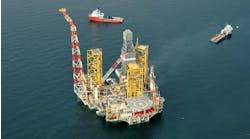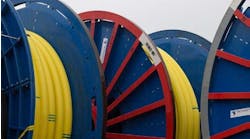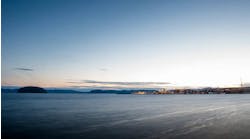Accurate assessment of gas hydrate deposits in seafloor sediments requires an integrated survey strategy of acoustic mapping and ground-truth sampling. The methods need to be specific to gas hydrate as they produce shallower resource targets than conventional hydrocarbons.
Hydrate and associated gas deposits always occur in the upper 1.5 km of the seafloor in marine sediments that are often minimally differentiated. Hydrate also introduces an environmental factor by influencing seafloor stability and safety in the top few hundred meters of sediment. The physical properties of gas hydrate determine safety and energy issues that are now being recognized in continental slope sediments on a global scale.
Seismic reflection surveys have revealed gas hydrate through acoustic blanking, and the identification of the strong bottom simulating reflector (BSR) seen at the base of the hydrate where free gas is present beneath the hydrate. Acoustic imagery of the seafloor has revealed pockmarks, mud diapirs, or volcanoes, and large collapse features that appear to be related to methane gas escape.
These surveys have also imaged large-scale slope disturbances and sediment mass movements attributed to gas hydrate induced instability. The distribution and physical properties of gas hydrates are still relatively unknown, although larger scale failures appear to correlate with regions of higher gas hydrate occurrence, at least on the European margins and off the U.S. East Coast.
Definition, occurrence
Gas hydrates are shallow phenomena often missed by deeper penetrating commercial surveys. As a resource, they lie 200-800 meters depth below the seafloor. Japan has stated that their gas hydrate resources are on the brink of being considered as reserves. India is also actively mapping hydrate in its territorial seas. Existing technology requires "tuning" of current acoustic geophysical systems in order to effectively address either hydrate energy or safety issues.
In deepwater, the pressure is great enough to stabilize methane as hydrate within the sediment. Rising temperature with depth defines the base of the hydrate stability zone (HSZ), commonly hundreds of meters beneath the seabed. The hydrate economic zone (HEZ) is the combined hydrate, gas, and deeper sediment zone relevant to methane recovery that shows the effects of hydrate formation and dissociation.
Variation in seafloor water temperature and in sea level can cause the base of the hydrate to rise and fall. Gas hydrate forms in seafloor sediments where sufficient gas is available to form hydrate in inter-granular pore spaces. Hydrate formation is promoted when sediments with a high organic content are rapidly deposited so that considerable methane can be produced as a byproduct of bacterial reduction. These conditions are most commonly met along continental margins.
Hydrate resource and safety issues generally occur at different levels in the HSZ. Concentrations of hydrate in the lower part of the HSZ and the underlying free gas create the primary interest in hydrate as a resource. It is this potential for extracting methane from oceanic deposits that is driving the research development interest in both India and Japan.
Dispersed hydrate at or near the seafloor can be important to sediment stability should it rapidly dissociate. The stability of the seafloor on a geological scale, however, is important in shaping the continental margin. The redistribution of sediments away from continental margins by sediment mass movement (with possible formation of a tsunami) highlights the environmental impact. The survey objectives are to understand what controls gas hydrate formation and map the extent of gas hydrate deposits.
Mapping hydrates
To map the gas hydrate concentration and measure the gas escape through the seabed, it is necessary to carry out both regional geophysical surveys and detailed observation as part of an integrated survey. This relates the morphology, geology, and physics of the seabed and enables more precise estimates of the affect of the oceanic hydrate on global atmospheric, greenhouse and climate issues. Acoustic geophysical methods already available can be used to begin the measurement of hydrate distribution and parameters.
Seismic reflection is the main tool for looking into the seafloor. Gas hydrate will normally show seismic compressional velocities (Vp) higher than those found in normal oceanic sediment and raise the bulk modulus of the sediment mass. Cementation of the sediment pore spaces alters the shear moduli (Vs) of the sediments. Vs can be measured using ocean bottom seismometers (OBS) to analyze surface waves, generated by a seabed impulse source. Hydrate formation may generate seismic blanking on record sections by overprinting the original acoustic structure within the sediment.
An ideal survey would measure both P and S-waves and use a hydrophone array at or close to the seafloor to measure attenuation. Multi-channel seismic data, the standard marine geophysical tool, is essential to carry out velocity analysis for depth and thickness estimates of hydrate concentrations. However, it is likely that no multi-channel seismic processing is required in addition to velocity analyses to most effectively image the BSR.
Single channel seismic
Single channel seismic reflection may be adequate for simply identifying the presence of gas hydrate through hydrate blanking and BSR distribution. It is less expensive to operate, can be acquired by non-specialist vessels, and surveyed at higher speeds. Much data of this type already exists and is suitable for reprocessing to re-interpret the relevant targets.
This does not involve the expense of data acquisition and is particularly in line with current thinking on environmental information usage. Regional appraisal can also utilize the vast amount of older data that exits from earlier surveys. Those not available in digital form can be transcribed for re-processing and interpretation.
Low energy, high-resolution "boomers," and medium energy, medium resolution "sparkers" can be towed at the same time, with alternate energy sources received on a single towed array. This technique allows the characteristics of both the uppermost and somewhat deeper strata and structure to be imaged together, with no offset errors.
Profilers, 3D systems
Chirp sonar systems are wide-band sub-bottom profilers. These are most successful at higher frequencies (3.5 kHz and up) but the high resolution and improved signal-to-noise ratios must be offset against the restricted depth penetration into the sediment, generally about 60 meters. These systems also provide sediment classification information from the seabed using reflection coefficients.
3D seismic systems involve the towing of multiple hydrophone arrays and tuned multiple towed sources. Both are towed near the surface. The multi-path analyses possible from these data allows for very fine-scale resolution and mapping of impedance contrasts and determination of physical properties. This type of survey would be very appropriate for detailed hydrate research.
Special seismic systems use unconventional source and receiver array locations. They give better resolution along track and produce very detailed velocity analyses. DTAGS, Pasisar, and Parasound systems fall into this category.
Side-scan systems
Side-scan sonar systems use the intensity and travel time of back-scattered acoustic energy to produce seafloor acoustic imagery. The acoustic intensities are mainly dependent on the reflectivity of the seafloor and bottom penetration. This is the main tool for imaging seafloor morphology and texture critical to assessing gas escape from the seafloor.
The Gloria system maps the seabed in swaths up to 60 km wide, at a 6-8 knot survey speed. This enables rapid wide-area surveys. The system is known to be capable of penetrating several meters into unconsolidated sediments to enable structures to be seen beneath the masking sediment veneers that are not visible higher frequency systems.
TOBI enables high-resolution marine surveys with co-registered side-scan sonar and swath bathymetry, particularly in deeper off-shelf environments. This provides high quality 3D images of the sea floor. It is a deep-towed highly flexible instrument operational to depths of 6,000 meters. TOBI generates a 6-km high-resolution swath side-scan sonar with swath bathymetry. It also has a 7.5 kHz sub-bottom profiler. Although operational at low speed, it has proven useful for exploration, engineering, and license blocks site surveys.
SeaMarcII is a deep seafloor mapping system, which consists of two sets of acoustic arrays mounted in a 5-meter long neutrally buoyant vehicle. It is shallow-towed below the top of the seasonal thermocline, approximately 400 meters behind the ship at a good speed. It is capable of producing up to 20-km wide swaths of acoustic back-scatter imagery. Advanced data processing allows for production of high resolution, equal area, essentially geo-referenced images.
There are a large number of relatively inexpensive, small and high-resolution side-scans commercially available. This type of side-scan is usually restricted to shallow water less than 250 meters.
Other special side-scan systems - synthetic apature (SAS) and parametric sonar - may also have applications. Commercial side-scan systems for seafloor acoustic imagery are probably sufficient for characterizing seafloor for the effects of gas passage, but much research remains to be done in processing the content of the back-scatter energy to extract physical properties of solid and dispersed hydrate.
Recommendations
The acoustic survey tools required for survey of seafloor containing hydrate for its energy aspects already exist, but need to be optimized. Methods for quantifying hydrate volumes, disposition, degree of cementation etc., are in the very early stages of development. Survey methods for dispersed hydrate that most strongly affect seafloor safety are not yet well understood, and much of the equipment that may prove useful has not yet been rigorously researched.
Site surveys require high-resolution sampling and long-term monitoring. Ground-truthing calibrates regional surveys and derives results to constrain the interpretation of the survey and generate the real-time production of integrated data sets.
We need methods for preserving gas hydrates under in-situ conditions as this form dissociates readily when subjected to pressure and temperature changes. In addition, equipment should be developed for the study of dispersed hydrate in-situ on and immediately beneath the seafloor. Control sites can be occupied for concentrated hydrate, dispersed hydrate, energy, seafloor stability, safety, and global carbon cycle interaction. The seafloor and water-column are much more accessible to monitoring, direct observation, and sampling than deeper targets.
It is possible to optimize a general survey strategy because gas hydrates occur in the same seafloor depth ranges worldwide. First, data on many regions already exists. Much of this can be revisited as desk studies; other data can be reprocessed and reinterpreted. Heat flow and sediment thickness data can produce hydrate thickness predictions. The use of the appropriately configured equipment in regional surveys is necessary prior to site analysis.
Information gained to support seismic analysis of hydrate may also be directly applicable to global carbon cycle and seafloor stability studies. This stresses the desirability for the compilation of diverse hydrate datasets. The HEZ is accessible to 3D characterization by integrating bathymetric and acoustic information from the seafloor that cannot be used on deeper targets. The seafloor data can be used to control results from deeper in the HEZ and provide data about gas escape.


